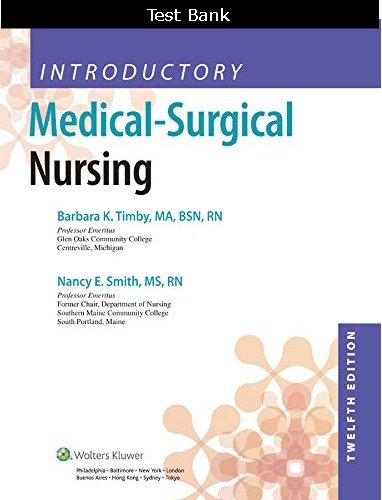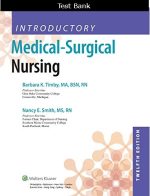This 12th edition of Introductory Medical-Surgical Nursing, along with its online resources, provides PN/VN students with the necessary knowledge and skills to provide safe and effective nursing care for adult medical-surgical clients in today’s ever-changing healthcare landscape. It features accessible content enhanced by photos and illustrations that reinforce learning and bring the information to life. The edition includes online videos, animations, audio, NCLEX-PN® review questions, and much more to help students prepare for real-world nursing and NCLEX-PN success.
KEY FEATURES
- Concept Mastery Alerts: These help clarify commonly misunderstood concepts.
- Concept Care Maps: These present a visual diagram focusing on the priority problem, expected outcomes, and nursing interventions of the client in the accompanying clinical scenario. Critical thinking questions follow the scenarios.
- Over 30 Nursing Care Plans: These include rationales and address issues such as Alzheimer’s disease, cancer, myocardial infarction, stroke, diabetes mellitus, modified radical mastectomy, and chronic renal failure, to help students develop a solid understanding of nursing care.
- Revised NCLEX-PN questions, as well as NEW alternate format questions, now align with the latest NCLEX-PN test plan.
- Nursing Process sections in each clinical chapter emphasize a nursing process approach to care and provide rationales in italics for all interventions.
- Nutrition Notes cover the special nutritional needs of clients with certain types of conditions.
- Pharmacologic Considerations highlight the special considerations students need to remember when caring for clients who are receiving specific drugs.
- Evidence-Based Practice boxes, including a Clinical Question, Evidence, and Nursing Implications, illustrate how research relates to practice.
- Gerontologic Considerations enhance understanding of how pathophysiology, signs and symptoms, and nursing care differ for the older population.
- Stop, Think, and Respond exercises increase recall and practical assimilation of concepts.
- Drug Therapy Tables list examples of generic and trade names, mechanisms of action, common side effects, and nursing considerations.
- An unparalleled suite of online Instructor Resources includes new LPN Concept-Based Curriculum Maps, a test generator, image bank, QSEN Competency KSAs, syllabus, guided lecture notes, discussion topics, lesson plans, PowerPoint presentations, LMS Course Cartridges, case studies, strategies for effective teaching, assignments, pre-lecture quizzes, and more.
This leading content is also incorporated into Lippincott CoursePoint, a dynamic learning solution that integrates the book’s curriculum, adaptive learning tools, real-time data reporting, and the latest evidence-based practice content together into one powerful student education solution. Lippincott CoursePoint improves nursing students’ critical thinking and clinical reasoning skills to prepare them for practice. Learn more at NursingEducationSuccess.com/CoursePoint.
Table of Contents
Title Page
Brief Contents
Copyright Page
Contributors and Reviewers
User Guide Features and Learning Tools
Preface
Acknowledgments
Contents
UNIT 1 Nursing Roles and Responsibilities
1 Concepts and Trends in Healthcare
Concepts Related to Health
Healthcare
Financing the Costs of Healthcare
Changes and Trends in Healthcare
2 Settings and Models for Nursing Care
Nursing Care
Settings and Types of Nursing Care
Models for Nursing Care Delivery
3 The Nursing Process
Steps of the Nursing Process
The Nursing Process and Clinical Reasoning/Critical Thinking
Concept Care Mapping
4 Interviewing and Physical Assessment
The Interview Process
The Physical Assessment
5 Legal and Ethical Issues
Legal Issues in Nursing Practice
Ethical Issues in Nursing Practice
6 Leadership Roles and Management Functions
Leadership and Management
The LPN/LVN as Leader/Manager
UNIT 2 Client Care Concerns
7 Nurse–Client Relationships
Scope of the Nurse–Client Relationship
Communication
Client Teaching
8 Cultural Care Considerations
Cultural Concepts
Culturally Influenced Characteristics
Assessment Considerations
Transcultural Nursing
9 Integrative Medicine and Alternative Therapies
Alternative Medical Systems
Changes in Western Medicine
Research and Development of Integrative Medicine
Nursing Role in Integrative Medicine and Alternative Therapies
10 End-of-Life Care
Supporting the Dying Client
Care Options for the Dying Client
Signs of Approaching Death
Nursing Management for End-of-Life Care
UNIT 3 Foundations of Medical-Surgical Nursing
11 Pain Management
Types of Pain
Pain Transmission
Pain Assessment
Pain Management
12 Infection
Infectious Agents and Infectious Disorders
Transmission of Infection
Defenses Against Infection
Pathophysiology of Infection
Sepsis
Types of Infections
Infection Control and Prevention
Care of the Client with Infection
13 Intravenous Therapy
Indications for Intravenous Therapy
Types of Intravenous Solutions
Administering Intravenous Therapy
Special Considerations for Intravenous Therapy
14 Perioperative Care
Preoperative Care
Intraoperative Care
Postoperative Care
15 Disaster Situations
Characteristics of Disasters
Types of Disasters
Human Disasters
Biologic Disasters
Chemical Disasters
Disaster Management
The Role of Nurses in A Disaster
UNIT 4 Caring for Clients With Multisystem Disorders
16 Caring for Clients With Fluid, Electrolyte, and Acid–Base Imbalances
Fluid and Electrolyte Balance
Fluid Imbalances
Electrolyte Imbalances
Acid–Base Balance
Acid–Base Imbalances
17 Caring for Clients in Shock
18 Caring for Clients With Cancer
Understanding Cancer
Treatment of Cancer
Nursing Management of the Client with Cancer
UNIT 5 Caring for Clients With Respiratory Disorders
19 Introduction to the Respiratory System
Respiratory Anatomy
Respiratory Physiology
Assessment
Nursing Management
20 Caring for Clients With Upper Respiratory Disorders
Infectious and Inflammatory Disorders
Structural Disorders
Trauma And Obstruction of the Upper Airway
Laryngeal Cancer
Treatment Modalities for Airway Obstruction or Airway Maintenance
21 Caring for Clients With Lower Respiratory Disorders
Infectious and Inflammatory Disorders
Obstructive Pulmonary Diseases
Occupational Lung Diseases
Pulmonary Circulatory Disorders
Respiratory Failure
Acute Respiratory Distress Syndrome
Malignant Disorders
Trauma
Thoracic Surgery
UNIT 6 Caring for Clients With Cardiovascular Disorders
22 Introduction to the Cardiovascular System
Anatomy and Physiology
Assessment of the Cardiovascular System
23 Caring for Clients With Infectious and Inflammatory Disorders of the Heart and Blood Vessels
Infectious and Inflammatory Disorders of the Heart
Inflammatory Disorders of the Peripheral Blood Vessels
24 Caring for Clients With Valvular Disorders of the Heart
Disorders of the Aortic Valve
Disorders of the Mitral Valve
25 Caring for Clients With Disorders of Coronary and Peripheral Blood Vessels
Arteriosclerosis
Atherosclerosis
Occlusive Disorders of Coronary Blood Vessels
Occlusive Disorders of Peripheral Blood Vessels
Disorders of Blood Vessel Walls
26 Caring for Clients With Cardiac Arrhythmias
Cardiac Arrhythmias
27 Caring for Clients With Hypertension
Physiology of Blood Pressure
Measuring Blood Pressure
Hypertensive Disease
28 Caring for Clients With Heart Failure
Heart Failure
Cardiogenic Pulmonary Edema
29 Caring for Clients Undergoing Cardiovascular Surgery
Cardiac Surgical Procedures
Central or Peripheral Vascular Surgical Procedures
Nursing Management for the Client Undergoing Cardiovascular Surgery
UNIT 7 Caring for Clients With Hematopoietic and Lymphatic Disorders
30 Introduction to the Hematopoietic and Lymphatic Systems
Anatomy and Physiology
Assessment
Nursing Management
31 Caring for Clients With Disorders of the Hematopoietic System
Anemia
Erythrocytosis
Leukocytosis
Multiple Myeloma
Agranulocytosis
Pancytopenia
Coagulopathies
32 Caring for Clients With Disorders of the Lymphatic System
Occlusive, Inflammatory, and Infectious Disorders
Lymphomas
UNIT 8 Caring for Clients With Immune Disorders
33 Introduction to the Immune System
Anatomy and Physiology
Types of Immunity
Assessment
34 Caring for Clients With Immune-Mediated Disorders
Allergic Disorders
Autoimmune Disorders
Chronic Fatigue Syndrome
35 Caring for Clients With HIV/AIDS
HIV
AIDS
UNIT 9 Caring for Clients With Neurologic Disorders
36 Introduction to the Nervous System
Anatomy and Physiology
Assessment
37 Caring for Clients With Central and Peripheral Nervous System Disorders
Increased Intracranial Pressure
Infectious and Inflammatory Disorders of the Nervous System
Neuromuscular Disorders
Cranial Nerve Disorders
Extrapyramidal Disorders
Seizure Disorders
Brain Tumors
38 Caring for Clients With Cerebrovascular Disorders
Headache
Transient Ischemic Attacks
Cerebrovascular Accident (Stroke)
Cerebral Aneurysms
39 Caring for Clients With Head and Spinal Cord Trauma
Head Injuries
Spinal Cord Injuries
Spinal Nerve Root Compression
40 Caring for Clients With Neurologic Deficits
Phases of a Neurologic Deficit
Psychosocial Issues and Home Management
UNIT 10 Caring for Clients With Sensory Disorders
41 Introduction to the Sensory System
The Eyes
The Ears
42 Caring for Clients With Eye Disorders
Impaired Vision
Infectious and Inflammatory Eye Disorders
Age-Related Macular Degeneration
Glaucoma
Cataracts
Retinal Detachment
Enucleation
43 Caring for Clients With Ear Disorders
Hearing Impairment
Disorders of the External Ear
Disorders of the Middle Ear
Disorders of the Inner Ear
UNIT 11 Caring for Clients With Gastrointestinal Disorders
44 Introduction to the Gastrointestinal System and Accessory Structures
Anatomy and Physiology
Assessment
45 Caring for Clients With Disorders of the Upper Gastrointestinal Tract
Disorders That Affect Eating
Disorders of the Esophagus
Gastric Disorders
46 Caring for Clients With Disorders of the Lower Gastrointestinal Tract
Altered Bowel Elimination
Inflammatory Bowel Disease
Ulcerative Colitis
Acute Abdominal Inflammatory Disorders
Intestinal Obstruction
Diverticular Disorders
Abdominal Hernia
Cancers of the Colon and Rectum
Anorectal Disorders
47 Caring for Clients With Disorders of the Liver, Gallbladder, or Pancreas
Disorders of the Liver
Disorders of the Gallbladder
Disorders of the Pancreas
48 Caring for Clients With Ostomies
Ileostomy
Colostomy
UNIT 12 Caring for Clients With Endocrine Disorders
49 Introduction to the Endocrine System
Anatomy and Physiology
Assessment
Nursing Management
50 Caring for Clients With Disorders of the Endocrine System
Disorders of the Pituitary Gland
Disorders of the Thyroid Gland
Disorders of the Parathyroid Glands
Disorders of the Adrenal Glands
51 Caring for Clients With Diabetes Mellitus
Diabetes Mellitus
Acute Complications of Diabetes Mellitus
Chronic Complications of Diabetes Mellitus
UNIT 13 Caring for Clients With Breast and Reproductive Disorders
52 Introduction to the Female and Male Reproductive Systems
The Female Reproductive System
The Breasts
The Male Reproductive System
53 Caring for Clients With Disorders of the Female Reproductive System
Disorders of Menstruation
Menopause
Infectious and Inflammatory Disorders
Structural Abnormalities
Tumors of the Female Reproductive System
54 Caring for Clients With Breast Disorders
Infectious and Inflammatory Breast Disorders
Benign Breast Lesions
Malignant Breast Disorders
Cosmetic Breast Procedures
55 Caring for Clients With Disorders of the Male Reproductive System
Structural Abnormalities
Infectious and Inflammatory Conditions
Erection Disorders
Benign Prostatic Hyperplasia
Malignancies of the Male Reproductive System
Elective Sterilization
56 Caring for Clients With Sexually Transmitted Infections
Epidemiology
Common Sexually Transmitted Infections
Other Sexually Transmitted Infections
UNIT 14 Caring for Clients With Urinary and Renal Disorders
57 Introduction to the Urinary System
Anatomy and Physiology
Assessment
58 Caring for Clients With Disorders of the Kidneys and Ureters
Infectious and Inflammatory Disorders of the Kidney
Congenital Kidney Disorders: Polycystic Kidney Disease
Obstructive Disorders
Kidney Failure
Dialysis
59 Caring for Clients With Disorders of the Bladder and Urethra
Voiding Dysfunction
Infectious and Inflammatory Disorders
Obstructive Disorders
Bladder Cancer
Trauma
UNIT 15 Caring for Clients With Musculoskeletal Disorders
60 Introduction to the Musculoskeletal System
Anatomy and Physiology
Assessment
Nursing Management
61 Caring for Clients Requiring Orthopedic Treatment
Casts
Splints and Braces
Reducing Fractures
Orthopedic Surgery
62 Caring for Clients With Traumatic Musculoskeletal Injuries
Strains, Contusions, and Sprains
Dislocations
Specific Injuries to Upper and Lower Extremities
Fractures
63 Caring for Clients With Orthopedic and Connective Tissue Disorders
Inflammatory Disorders
Musculoskeletal Infectious Disorders
Structural Disorders
Bone Tumors
UNIT 16 Caring for Clients With Integumentary Disorders
64 Introduction to the Integumentary System
Anatomy And Physiology
Assessment
Medical and Surgical Treatment of Skin Disorders
65 Caring for Clients With Skin, Hair, and Nail Disorders
Skin Disorders
Body Ornamentation
Scalp and Hair Disorders
Nail Disorders
66 Caring for Clients With Burns
Burn Statistics
Burn Injuries
UNIT 17 Caring for Clients With Psychobiologic Disorders
67 Interaction of Body and Mind
The Brain and Psychobiologic Function
Psychobiologic Illness
The Brain and Psychosomatic Function
Psychosomatic Illnesses
Psychobiologic Intervention: The Placebo Effect
68 Caring for Clients With Anxiety Disorders
Anxiety and Fear
Anxiety Disorders
69 Caring for Clients With Mood Disorders
The Mood Continuum and Mood Disorders
Major Depression
Suicidality
Seasonal Affective Disorder
Bipolar Disorder
70 Caring for Clients With Eating Disorders
Anorexia Nervosa
Bulimia Nervosa
Binge Eating Disorder and Compulsive Overeating
71 Caring for Clients With Chemical Dependence
Substance Abuse and Chemical Dependence
72 Caring for Clients With Dementia and Thought Disorders
Delirium and Dementia
Alzheimer’s Disease
Schizophrenia
Appendix A Commonly Used Abbreviations and Acronyms
Glossary
Index



Selia –
I would give it five stars. Legit seller
David –
Another great seller. thank you